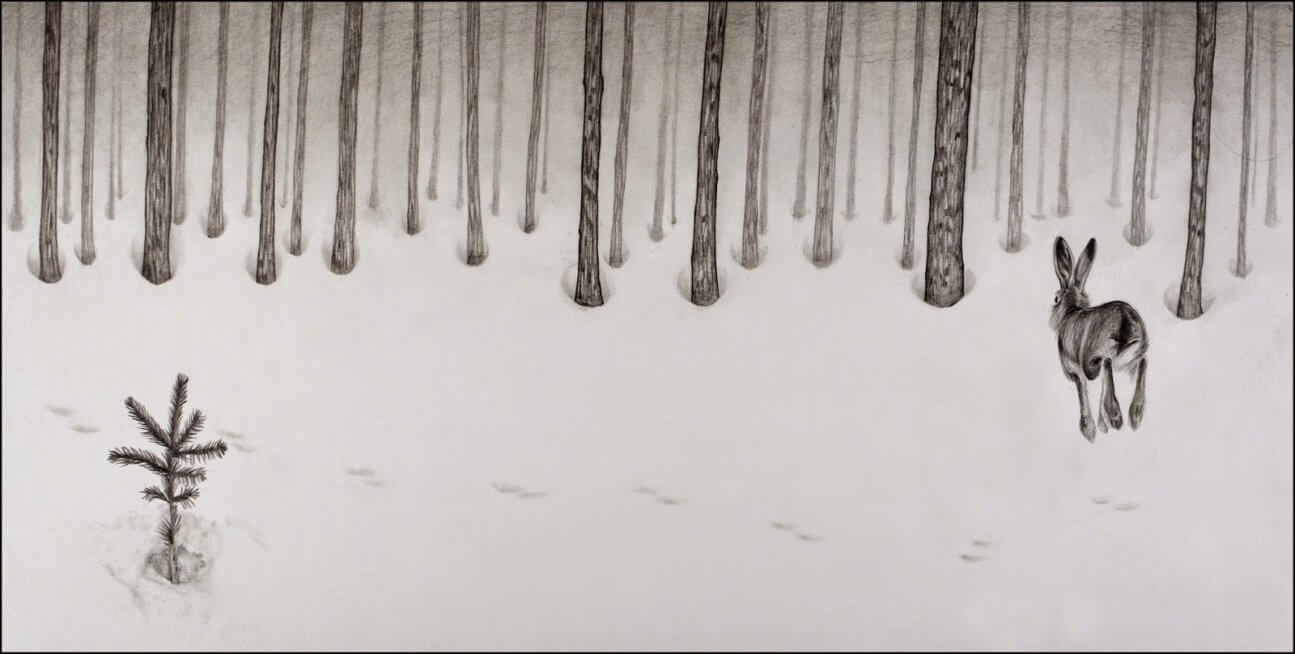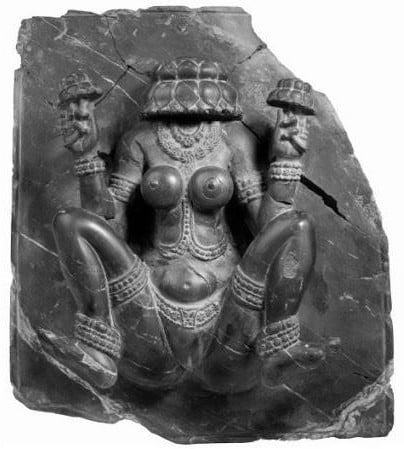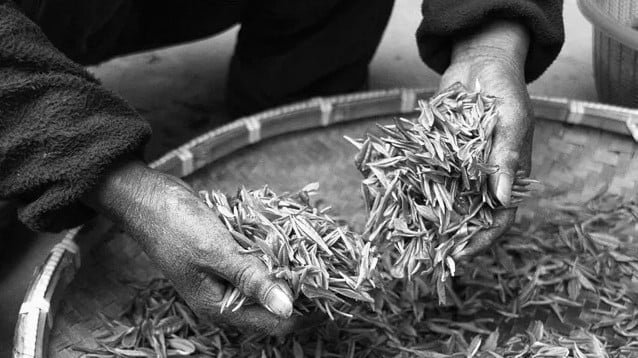Grantræet, The Fir Tree, is a literary fairy tale by Danish poet and author Hans Christian Andersen. Although a prolific writer of plays, travelogues, novels, and poems, Andersen is best remembered for his fairy tales. Discover the tale and the traditional uses of the fir tree.
In this Article
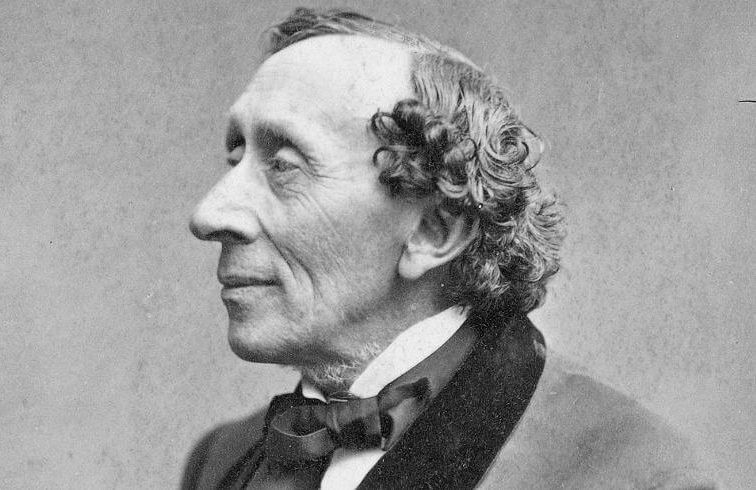
Hans Christian Andersen (1805 – 1875) was born in Odense, Denmark on April 2, 1805. Although a prolific writer of plays, travelogues, novels, and poems, Andersen is best remembered for his fairy tales.
Andersen’s popularity is not limited to children: his stories express themes that transcend age and nationality.
The tale Grantræet, The Fir Tree, was first published on the 21st of December 1844 with “The Snow Queen”, in Copenhagen, Denmark, by C.A. Reitzel.
Andersen‘s fairy tales, which have been translated into more than 125 languages. Some of his most famous fairy tales include “The Emperor’s New Clothes”, “The Little Mermaid”, “The Nightingale”, “The Snow Queen”, “The Ugly Duckling”, “The Little Match Girl”, “The fir tree”, and many others.
His stories have become culturally embedded in the European folklore, readily accessible to children, but presenting lessons of virtue and resilience in the face of adversity for mature readers as well.
The stories have inspired motion pictures, plays, ballets, and animated films.
Enjoy the version of Jean Hersholt (1886-1956), a Danish actor who emigrated to the United States, he was an avid collector of Andersen editions, and among other things he translated Hans Christian Andersen’s fairy tales and stories in the edition, “The Complete Andersen” in six volumes, you may now read “The fir tree”. Hersholt’s Andersen-translation for the English languages world is rated as the standard translation.
I grow up with “The Fir Tree”, my beloved grandmother used to tell me this story about getting adult, not only around Christmas time…
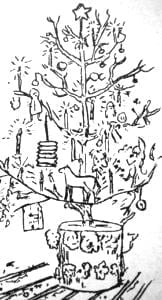
Fairy tale : The fir tree
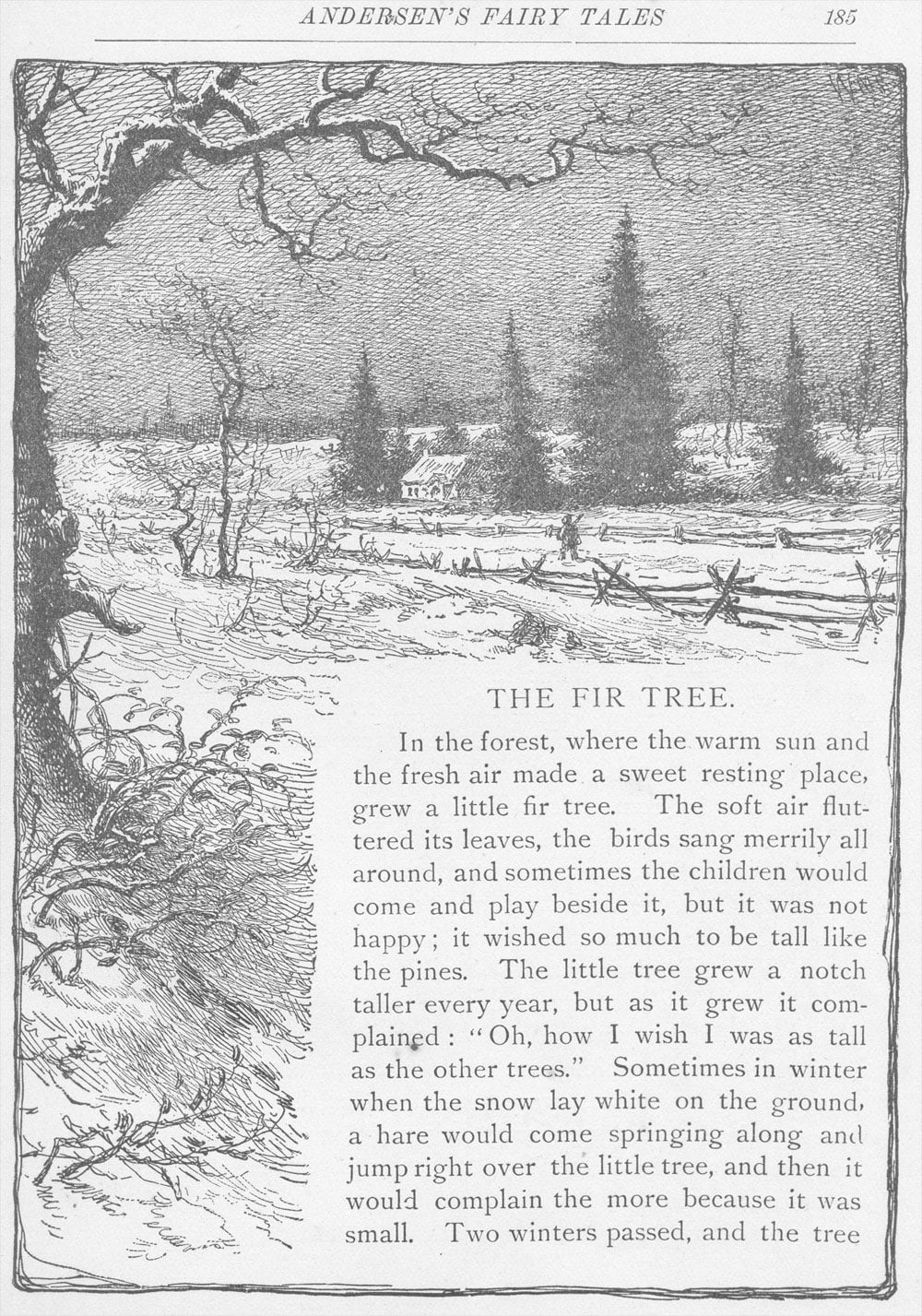
Out in the woods stood such a pretty little fir tree. It grew in a good place, where it had plenty of sun and plenty of fresh air. Around it stood many tall comrades, both fir trees and pines.
The little fir tree was in a headlong hurry to grow up. It didn’t care a thing for the warm sunshine, or the fresh air, and it took no interest in the peasant children who ran about chattering when they came to pick strawberries or raspberries. Often when the children had picked their pails full, or had gathered long strings of berries threaded on straws, they would sit down to rest near the little fir. “Oh, isn’t it a nice little tree?” they would say. “It’s the baby of the woods.” The little tree didn’t like their remarks at all.
Next year it shot up a long joint of new growth, and the following year another joint, still longer. You can always tell how old a fir tree is by counting the number of joints it has.
“I wish I were a grown-up tree, like my comrades,” the little tree sighed. “Then I could stretch out my branches and see from my top what the world is like. The birds would make me their nesting place, and when the wind blew I could bow back and forth with all the great trees.”
It took no pleasure in the sunshine, nor in the birds. The glowing clouds, that sailed overhead at sunrise and sunset, meant nothing to it.
In winter, when the snow lay sparkling on the ground, a hare would often come hopping along and jump right over the little tree. Oh, how irritating that was! That happened for two winters, but when the third winter came the tree was so tall that the hare had to turn aside and hop around it.
“Oh, to grow, grow! To get older and taller,” the little tree thought. “That is the most wonderful thing in this world.”
In the autumn, woodcutters came and cut down a few of the largest trees. This happened every year. The young fir was no longer a baby tree, and it trembled to see how those stately great trees crashed to the ground, how their limbs were lopped off, and how lean they looked as the naked trunks were loaded into carts. It could hardly recognize the trees it had known, when the horses pulled them out of the woods.
Where were they going? What would become of them?
In the springtime, when swallows and storks came back, the tree asked them, “Do you know where the other trees went? Have you met them?”
The swallows knew nothing about it, but the stork looked thoughtful and nodded his head. “Yes, I think I met them,” he said. “On my way from Egypt I met many new ships, and some had tall, stately masts. They may well have been the trees you mean, for I remember the smell of fir. They wanted to be remembered to you.”
“Oh, I wish I were old enough to travel on the sea. Please tell me what it really is, and how it looks.”
“That would take too long to tell,” said the stork, and off he strode.
“Rejoice in your youth,” said the sunbeams. “Take pride in your growing strength and in the stir of life within you.”
And the wind kissed the tree, and the dew wept over it, for the tree was young and without understanding.
When Christmas came near, many young trees were cut down. Some were not even as old or as tall as this fir tree of ours, who was in such a hurry and fret to go traveling. These young trees, which were always the handsomest ones, had their branches left on them when they were loaded on carts and the horses drew them out of the woods.
“Where can they be going?” the fir tree wondered. “They are no taller than I am. One was really much smaller than I am. And why are they allowed to keep all their branches? “Where can they be going?”
“We know! We know!” the sparrows chirped. “We have been to town and peeped in the windows. We know where they are going. The greatest splendor and glory you can imagine awaits them. We’ve peeped through windows. We’ve seen them planted right in the middle of a warm room, and decked out with the most splendid things – gold apples, good gingerbread, gay toys, and many hundreds of candles.”
“And then?” asked the fir tree, trembling in every twig. “And then? What happens then?”
“We saw nothing more. And never have we seen anything that could match it.”
“I wonder if I was created for such a glorious future?” The fir tree rejoiced. “Why, that is better than to cross the sea. I’m tormented with longing. Oh, if Christmas would only come! I’m just as tall and grown-up as the trees they chose last year. How I wish I were already in the cart, on my way to the warm room where there’s so much splendor and glory. Then-then something even better, something still more important is bound to happen, or why should they deck me so fine? Yes, there must be something still grander! But what? Oh, how I long: I don’t know what’s the matter with me.”
“Enjoy us while you may,” the air and sunlight told him. “Rejoice in the days of your youth, out here in the open.”
But the tree did not rejoice at all. It just grew. It grew and was green both winter and summer – dark evergreen. People who passed it said, “There’s a beautiful tree!” And when Christmas time came again they cut it down first. The ax struck deep into its marrow. The tree sighed as it fell to the ground. It felt faint with pain. Instead of the happiness it had expected, the tree was sorry to leave the home where it had grown up. It knew that never again would it see its dear old comrades, the little bushes and the flowers about it-and perhaps not even the birds. The departure was anything but pleasant.
The tree did not get over it until all the trees were unloaded in the yard, and it heard a man say, “That’s a splendid one. That’s the tree for us.” Then two servants came in fine livery, and carried the fir tree into a big splendid drawing-room. Portraits were hung all around the walls. On either side of the white porcelain stove stood great Chinese vases, with lions on the lids of them. There were easy chairs, silk-covered sofas and long tables strewn with picture books, and with toys that were worth a mint of money, or so the children said.
The fir tree was planted in a large tub filled with sand, but no one could see that it was a tub, because it was wrapped in a gay green cloth and set on a many-colored carpet. How the tree quivered! What would come next? The servants and even the young ladies helped it on with its fine decorations. From its branches they hung little nets cut out of colored paper, and each net was filled with candies. Gilded apples and walnuts hung in clusters as if they grew there, and a hundred little white, blue, and even red, candles were fastened to its twigs. Among its green branches swayed dolls that it took to be real living people, for the tree had never seen their like before. And up at its very top was set a large gold tinsel star. It was splendid, I tell you, splendid beyond all words!
“Tonight,” they all said, “ah, tonight how the tree will shine!”
“Oh,” thought the tree, “if tonight would only come! If only the candles were lit! And after that, what happens then? Will the trees come trooping out of the woods to see me? Will the sparrows flock to the windows? Shall I take root here, and stand in fine ornaments all winter and summer long?”
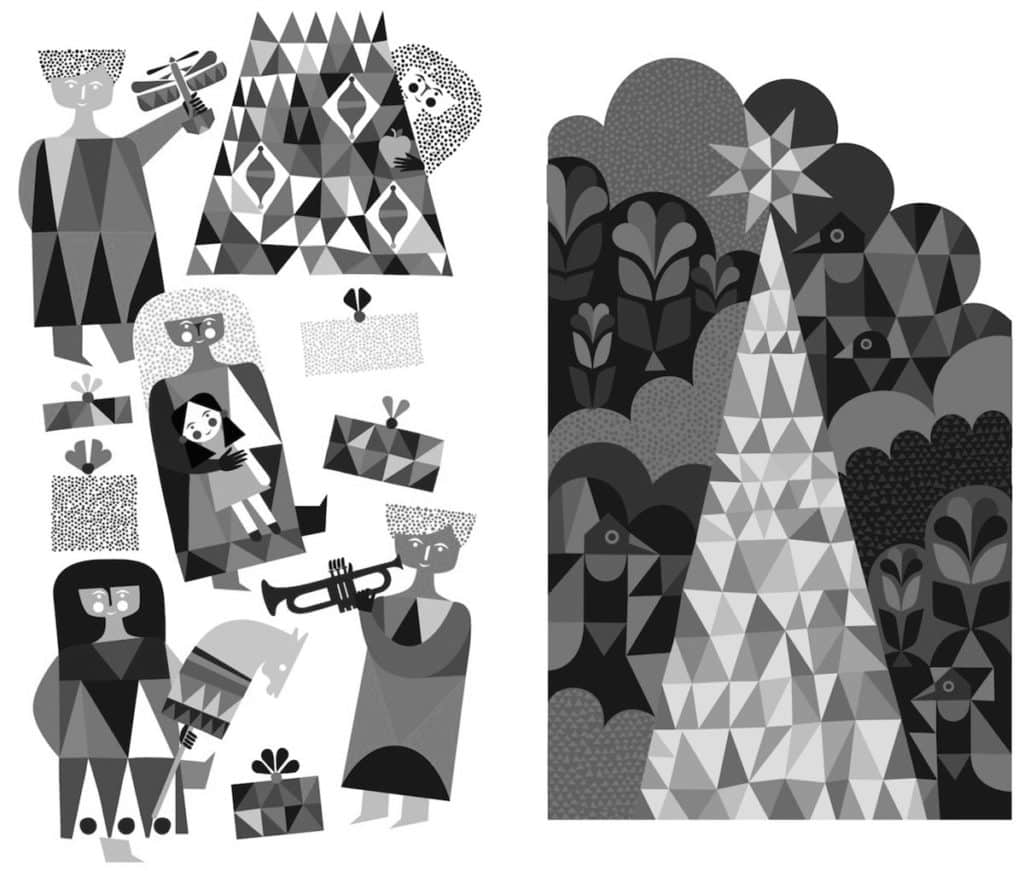
That was how much it knew about it. All its longing had gone to its bark and set it to arching, which is as bad for a tree as a headache is for us.
Now the candles were lighted. What dazzling splendor! What a blaze of light! The tree quivered so in every bough that a candle set one of its twigs ablaze. It hurt terribly.
“Mercy me!” cried every young lady, and the fire was quickly put out. The tree no longer dared rustle a twig – it was awful! Wouldn’t it be terrible if it were to drop one of its ornaments? Its own brilliance dazzled it.
Suddenly the folding doors were thrown back, and a whole flock of children burst in as if they would overturn the tree completely. Their elders marched in after them, more sedately. For a moment, but only for a moment, the young ones were stricken speechless. Then they shouted till the rafters rang. They danced about the tree and plucked off one present after another.
“What are they up to?” the tree wondered. “What will happen next?”
As the candles burned down to the bark they were snuffed out, one by one, and then the children had permission to plunder the tree. They went about it in such earnest that the branches crackled and, if the tree had not been tied to the ceiling by the gold star at top, it would have tumbled headlong.
The children danced about with their splendid playthings. No one looked at the tree now, except an old nurse who peered in among the branches, but this was only to make sure that not an apple or fig had been overlooked.
“Tell us a story! Tell us a story!” the children clamored, as they towed a fat little man to the tree. He sat down beneath it and said, “Here we are in the woods, and it will do the tree a lot of good to listen to our story. Mind you, I’ll tell only one. Which will you have, the story of Ivedy-Avedy, or the one about Humpty-Dumpty who tumbled downstairs, yet ascended the throne and married the Princess?”
“Ivedy-Avedy,” cried some. “Humpty-Dumpty,” cried the others. And there was a great hullabaloo. Only the fir tree held its peace, though it thought to itself, “Am I to be left out of this? Isn’t there anything I can do?” For all the fun of the evening had centered upon it, and it had played its part well.
The fat little man told them all about Humpty-Dumpty, who tumbled downstairs, yet ascended the throne and married the Princess. And the children clapped and shouted, “Tell us another one! Tell us another one!” For they wanted to hear about Ivedy-Avedy too, but after Humpty-Dumpty the story telling stopped. The fir tree stood very still as it pondered how the birds in the woods had never told it a story to equal this.
“Humpty-Dumpty tumbled downstairs, yet he married the Princess. Imagine! That must be how things happen in the world. You never can tell. Maybe I’ll tumble downstairs and marry a princess too,” thought the fir tree, who believed every word of the story because such a nice man had told it.
The tree looked forward to the following day, when they would deck it again with fruit and toys, candles and gold. “Tomorrow I shall not quiver,” it decided. “I’ll enjoy my splendor to the full. Tomorrow I shall hear about Humpty-Dumpty again, and perhaps about Ivedy-Avedy too.” All night long the tree stood silent as it dreamed its dreams, and next morning the butler and the maid came in with their dusters.
“Now my splendor will be renewed,” the fir tree thought. But they dragged it upstairs to the garret, and there they left it in a dark corner where no daylight ever came. “What’s the meaning of this?” the tree wondered. “What am I going to do here? What stories shall I hear?” It leaned against the wall, lost in dreams. It had plenty of time for dreaming, as the days and the nights went by. Nobody came to the garret. And when at last someone did come, it was only to put many big boxes away in the corner. The tree was quite hidden. One might think it had been entirely forgotten.
“It’s still winter outside,” the tree thought. “The earth is too hard and covered with snow for them to plant me now. I must have been put here for shelter until springtime comes. How thoughtful of them! How good people are! Only, I wish it weren’t so dark here, and so very, very lonely. There’s not even a little hare. It was so friendly out in the woods when the snow was on the ground and the hare came hopping along. Yes, he was friendly even when he jumped right over me, though I did not think so then. Here it’s all so terribly lonely.”

“Squeak, squeak!” said a little mouse just then. He crept across the floor, and another one followed him. They sniffed the fir tree, and rustled in and out among its branches.
“It is fearfully cold,” one of them said. “Except for that, it would be very nice here, wouldn’t it, you old fir tree?”
“I’m not at all old,” said the fir tree. “Many trees are much older than I am.”
“Where did you come from?” the mice asked him. “And what do you know?” They were most inquisitive creatures.
“Tell us about the most beautiful place in the world. Have you been there? Were you ever in the larder, where there are cheeses on shelves and hams that hang from the rafters? It’s the place where you can dance upon tallow candles – where you can dart in thin and squeeze out fat.”
“I know nothing of that place,” said the tree. “But I know the woods where the sun shines and the little birds sing.” Then it told them about its youth. The little mice had never heard the like of it. They listened very intently, and said, “My! How much you have seen! And how happy it must have made you.”
“I ?” the fir tree thought about it. “Yes, those days were rather amusing.” And he went on to tell them about Christmas Eve, when it was decked out with candies and candles.
“Oh,” said the little mice, “how lucky you have been, you old fir tree!”

“I am not at all old,” it insisted. “I came out of the woods just this winter, and I’m really in the prime of life, though at the moment my growth is suspended.”
“How nicely you tell things;” said the mice. The next night they came with four other mice to hear what the tree had to say. The more it talked, the more clearly it recalled things, and it thought, “Those were happy times. But they may still come back – they may come back again. Humpty-Dumpty fell downstairs, and yet he married the Princess. Maybe the same thing will happen to me.” It thought about a charming little birch tree that grew out in the woods. To the fir tree she was a real and lovely Princess.
“Who is Humpty-Dumpty?” the mice asked it. So the fir tree told them the whole story, for it could remember it word by word. The little mice were ready to jump to the top of the tree for joy. The next night many more mice came to see the fir tree, and on Sunday two rats paid it a call, but they said that the story was not very amusing. This made the little mice to sad that they began to find it not so very interesting either.
“Is that the only story you know?” the rats asked.
“Only that one,” the tree answered. “I heard it on the happiest evening of my life, but I did not know then how happy I was.”
“It’s a very silly story. Don’t you know one that tells about bacon and candles? Can’t you tell us a good larder story?”
“No,” said the tree.
“Then good – bye, and we won’t be back,” the rats said, and went away.
At last, the little mice took to staying away too. The tree sighed, “Oh, wasn’t it pleasant when those gay little mice sat around and listened to all that I had to say. Now that, too, is past and gone. But I will take good care to enjoy myself, once they let me out of here.”
When would that be? Well, it came to pass on a morning when people came up to clean out the garret. The boxes were moved, the tree was pulled out and thrown – thrown hard – on the floor. But a servant dragged it at once to the stairway, where there was daylight again.
“Now my life will start all over,” the tree thought. It felt the fresh air and the first sunbeam strike it as if it came out into the courtyard. This all happened so quickly and there was so much going around it, that the tree forgot to give even a glance at itself. The courtyard adjoined a garden, where flowers were blooming. Great masses of fragrant roses hung over the picket fence. The linden trees were in blossom, and between them the swallows skimmed past, calling, “Tilira-lira-lee, my love’s come back to me.” But it was not the fir tree of whom they spoke.
“Now I shall live again,” it rejoiced, and tried to stretch out its branches. Alas, they were withered, and brown, and brittle. It was tossed into a corner, among weeds and nettles. But the gold star that was still tied to its top sparkled bravely in the sunlight.
Several of the merry children, who had danced around the tree and taken such pleasure in it at Christmas, were playing in the courtyard. One of the youngest seized upon it and tore off the tinsel star.
“Look what is still hanging on that ugly old Christmas tree,” the child said, and stamped upon the branches until they cracked beneath his shoes.
The tree saw the beautiful flowers blooming freshly in the garden. It saw itself, and wished that they had left it in the darkest corner of the garret. It thought of its own young days in the deep woods, and of the merry Christmas Eve, and of the little mice who had been so pleased when it told them the story of Humpty-Dumpty.

“My days are over and past,” said the poor tree. “Why didn’t I enjoy them while I could? Now they are gone – all gone.”
A servant came and chopped the tree into little pieces. These heaped together quite high. The wood blazed beautifully under the big copper kettle, and the fir tree moaned so deeply that each groan sounded like a muffled shot. That’s why the children who were playing near-by ran to make a circle around the flames, staring into the fire and crying, “Pif! Paf!” But as each groans burst from it, the tree thought of a bright summer day in the woods, or a starlit winter night. It thought of Christmas Eve and thought of Humpty-Dumpty, which was the only story it ever heard and knew how to tell. And so, the tree was burned completely away.
The children played on in the courtyard. The youngest child wore on his breast the gold star that had topped the tree on its happiest night of all. But that was no more, and the tree was no more, and there’s no more to my story. No more, nothing more. All stories come to an end.
~ ○ ~
Variant II
Fairy tale : The fir tree
This variation is from Paull’s H. P. book “Fairy Tales and Stories.”
Ar down in the forest, where the warm sun and the fresh air made a sweet resting-place, grew a pretty little fir-tree; and yet it was not happy, it wished so much to be tall like its companions— the pines and firs which grew around it. The sun shone, and the soft air fluttered its leaves, and the little peasant children passed by, prattling merrily, but the fir-tree heeded them not. Sometimes the children would bring a large basket of raspberries or strawberries, wreathed on a straw, and seat themselves near the fir-tree, and say, “Is it not a pretty little tree?” which made it feel more unhappy than before.
And yet all this while the tree grew a notch or joint taller every year; for by the number of joints in the stem of a fir-tree we can discover its age. Still, as it grew, it complained, “Oh! how I wish I were as tall as the other trees, then I would spread out my branches on every side, and my top would over-look the wide world. I should have the birds building their nests on my boughs, and when the wind blew, I should bow with stately dignity like my tall companions.”
The tree was so discontented, that it took no pleasure in the warm sunshine, the birds, or the rosy clouds that floated over it morning and evening. Sometimes, in winter, when the snow lay white and glittering on the ground, a hare would come springing along, and jump right over the little tree; and then how mortified it would feel! Two winters passed, and when the third arrived, the tree had grown so tall that the hare was obliged to run round it. Yet it remained unsatisfied, and would exclaim
, “Oh, if I could but keep on growing tall and old! There is nothing else worth caring for in the world!”
In the autumn, as usual, the wood-cutters came and cut down several of the tallest trees, and the young fir-tree, which was now grown to its full height, shuddered as the noble trees fell to the earth with a crash.
After the branches were lopped off, the trunks looked so slender and bare, that they could scarcely be recognized. Then they were placed upon wagons, and drawn by horses out of the forest.
“Where were they going? What would become of them?”
The young fir-tree wished very much to know; so in the spring, when the swallows and the storks came, it asked, “Do you know where those trees were taken? Did you meet them?”
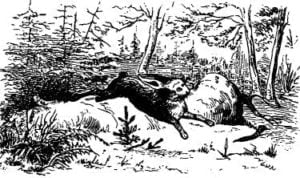
The swallows knew nothing, but the stork, after a little reflection, nodded his head, and said, “Yes, I think I do. I met several new ships when I flew from Egypt, and they had fine masts that smelt like fir. I think these must have been the trees; I assure you they were stately, very stately.”
“Oh, how I wish I were tall enough to go on the sea,” said the fir-tree. “What is the sea, and what does it look like?”
“It would take too much time to explain,” said the stork, flying quickly away.
“Rejoice in thy youth,” said the sunbeam; “rejoice in thy fresh growth, and the young life that is in thee.”
And the wind kissed the tree, and the dew watered it with tears; but the fir-tree regarded them not.
Christmas-time drew near, and many young trees were cut down, some even smaller and younger than the fir-tree who enjoyed neither rest nor peace with longing to leave its forest home. These young trees, which were chosen for their beauty, kept their branches, and were also laid on wagons and drawn by horses out of the forest.
“Where are they going?” asked the fir-tree. “They are not taller than I am: indeed, one is much less; and why are the branches not cut off? Where are they going?”
“We know, we know,” sang the sparrows; “we have looked in at the windows of the houses in the town, and we know what is done with them. They are dressed up in the most splendid manner.
We have seen them standing in the middle of a warm room, and adorned with all sorts of beautiful things, – honey cakes, gilded apples, playthings, and many hundreds of wax tapers.”
“And then,” asked the fir-tree, trembling through all its branches, “and then what happens?”
“We did not see any more,” said the sparrows; “but this was enough for us.”
“I wonder whether anything so brilliant will ever happen to me,” thought the fir-tree. “It would be much better than crossing the sea. I long for it almost with pain. Oh! when will Christmas be here? I am now as tall and well grown as those which were taken away last year.
Oh! that I were now laid on the wagon, or standing in the warm room, with all that brightness and splendor around me! Something better and more beautiful is to come after, or the trees would not be so decked out. Yes, what follows will be grander and more splendid. What can it be? I am weary with longing. I scarcely know how I feel.”
“Rejoice with us,” said the air and the sunlight. “Enjoy thine own bright life in the fresh air.”
But the tree would not rejoice, though it grew taller every day; and, winter and summer, its dark-green foliage might be seen in the forest, while passers by would say, “What a beautiful tree!”
A short time before Christmas, the discontented fir-tree was the first to fall. As the axe cut through the stem, and divided the pith, the tree fell with a groan to the earth, conscious of pain and faintness, and forgetting all its anticipations of happiness, in sorrow at leaving its home in the forest.
It knew that it should never again see its dear old companions, the trees, nor the little bushes and many-colored flowers that had grown by its side; perhaps not even the birds. Neither was the journey at all pleasant. The tree first recovered itself while being unpacked in the courtyard of a house, with several other trees; and it heard a man say, “We only want one, and this is the prettiest.”
Then came two servants in grand livery, and carried the fir-tree into a large and beautiful apartment. On the walls hung pictures, and near the great stove stood great china vases, with lions on the lids. There were rocking chairs, silken sofas, large tables, covered with pictures, books, and playthings, worth a great deal of money,—at least, the children said so.
Then the fir-tree was placed in a large tub, full of sand; but green baize hung all around it, so that no one could see it was a tub, and it stood on a very handsome carpet. How the fir-tree trembled! “What was going to happen to him now?”
Some young ladies came, and the servants helped them to adorn the tree. On one branch they hung little bags cut out of colored paper, and each bag was filled with sweetmeats; from other branches hung gilded apples and walnuts, as if they had grown there; and above, and all round, were hundreds of red, blue, and white tapers, which were fastened on the branches.
Dolls, exactly like real babies, were placed under the green leaves,- the tree had never seen such things before, – and at the very top was fastened a glittering star, made of tinsel. Oh, it was very beautiful!
“This evening,” they all exclaimed, “how bright it will be!” “Oh, that the evening were come,” thought the tree, “and the tapers lighted! then I shall know what else is going to happen. Will the trees of the forest come to see me? I wonder if the sparrows will peep in at the windows as they fly? shall I grow faster here, and keep on all these ornaments summer and winter?”
But guessing was of very little use; it made his bark ache, and this pain is as bad for a slender fir-tree, as headache is for us. At last, the tapers were lighted, and then what a glistening blaze of light the tree presented! It trembled so with joy in all its branches, that one of the candles fell among the green leaves and burnt some of them.
“Help! help!” exclaimed the young ladies, but there was no danger, for they quickly extinguished the fire. After this, the tree tried not to tremble at all, though the fire frightened him; he was so anxious not to hurt any of the beautiful ornaments, even while their brilliancy dazzled him.
And now the folding doors were thrown open, and a troop of children rushed in as if they intended to upset the tree; they were followed more silently by their elders. For a moment the little ones stood silent with astonishment, and then they shouted for joy, till the room rang, and they danced merrily round the tree, while one present after another was taken from it.
“What are they doing? What will happen next?” thought the fir. At last the candles burnt down to the branches and were put out. Then the children received permission to plunder the tree.
Oh, how they rushed upon it, till the branches cracked, and had it not been fastened with the glistening star to the ceiling, it must have been thrown down. The children then danced about with their pretty toys, and no one noticed the tree, except the children’s maid who came and peeped among the branches to see if an apple or a fig had been forgotten.
“A story, a story,” cried the children, pulling a little fat man towards the tree.
“Now we shall be in the green shade,” said the man, as he seated himself under it, “and the tree will have the pleasure of hearing also, but I shall only relate one story; what shall it be? Ivede-Avede, or Humpty Dumpty, who fell down stairs, but soon got up again, and at last married a princess.”
“Ivede-Avede,” cried some. “Humpty Dumpty,” cried others, and there was a fine shouting and crying out. But the fir-tree remained quite still, and thought to himself, “Shall I have anything to do with all this?” but he had already amused them as much as they wished.
Then the old man told them the story of Humpty Dumpty, how he fell down stairs, and was raised up again, and married a princess. And the children clapped their hands and cried, “Tell another, tell another,” for they wanted to hear the story of “Ivede-Avede;” but they only had “Humpty Dumpty.”
After this the fir-tree became quite silent and thoughtful; never had the birds in the forest told such tales as “Humpty Dumpty,” who fell down stairs, and yet married a princess.
“Ah! yes, so it happens in the world,” thought the fir-tree; he believed it all, because it was related by such a nice man. “Ah! well,” he thought, “who knows? perhaps I may fall down too, and marry a princess;” and he looked forward joyfully to the next evening, expecting to be again decked out with lights and playthings, gold and fruit.
“To-morrow I will not tremble,” thought he; “I will enjoy all my splendor, and I shall hear the story of Humpty Dumpty again, and perhaps Ivede-Avede.” And the tree remained quiet and thoughtful all night.
In the morning the servants and the housemaid came in. “Now,” thought the fir, “all my splendor is going to begin again.” But they dragged him out of the room and up stairs to the garret, and threw him on the floor, in a dark corner, where no daylight shone, and there they left him.
“What does this mean?” thought the tree, “what am I to do here? I can hear nothing in a place like this,” and he had time enough to think, for days and nights passed and no one came near him, and when at last somebody did come, it was only to put away large boxes in a corner. So, the tree was completely hidden from sight as if it had never existed.
“It is winter now,” thought the tree, “the ground is hard and covered with snow, so that people cannot plant me. I shall be sheltered here, I dare say, until spring comes. How thoughtful and kind everybody is to me! Still I wish this place were not so dark, as well as lonely, with not even a little hare to look at.
How pleasant it was out in the forest while the snow lay on the ground, when the hare would run by, yes, and jump over me too, although I did not like it then. Oh! it is terrible lonely here.”
“Squeak, squeak,” said a little mouse, creeping cautiously towards the tree; then came another; and they both sniffed at the fir-tree and crept between the branches.
“Oh, it is very cold,” said the little mouse, “or else we should be so comfortable here, shouldn’t we, you old fir-tree?”
“I am not old,” said the fir-tree, “there are many who are older than I am.”
“Where do you come from? and what do you know?” asked the mice, who were full of curiosity. “Have you seen the most beautiful places in the world, and can you tell us all about them? and have you been in the storeroom, where cheeses lie on the shelf, and hams hang from the ceiling? One can run about on tallow candles there, and go in thin and come out fat.”
“I know nothing of that place,” said the fir-tree, “but I know the wood where the sun shines and the birds sing.” And then the tree told the little mice all about its youth. They had never heard such an account in their lives; and after they had listened to it attentively, they said, “What a number of things you have seen? you must have been very happy.”
“Happy!” exclaimed the fir-tree, and then as he reflected upon what he had been telling them, he said, “Ah, yes! after all those were happy days.” But when he went on and related all about Christmas-eve, and how he had been dressed up with cakes and lights, the mice said, “How happy you must have been, you old fir-tree.”
“I am not old at all,” replied the tree, “I only came from the forest this winter, I am now checked in my growth.”
“What splendid stories you can relate,” said the little mice. And the next night four other mice came with them to hear what the tree had to tell.
The more he talked the more he remembered, and then he thought to himself, “Those were happy days, but they may come again. Humpty Dumpty fell down stairs, and yet he married the princess; perhaps I may marry a princess too.” And the fir-tree thought of the pretty little birch-tree that grew in the forest, which was to him a real beautiful princess.
“Who is Humpty Dumpty?” asked the little mice. And then the tree related the whole story; he could remember every single word, and the little mice was so delighted with it, that they were ready to jump to the top of the tree.
The next night a great many more mice made their appearance, and on Sunday two rats came with them; but they said, it was not a pretty story at all, and the little mice were very sorry, for it made them also think less of it.
“Do you know only one story?” asked the rats.
“Only one,” replied the fir-tree; “I heard it on the happiest evening of my life; but I did not know I was so happy at the time.”
“We think it is a very miserable story,” said the rats. “Don’t you know any story about bacon, or tallow in the storeroom.”
“No,” replied the tree.
“Many thanks to you then,” replied the rats, and they marched off.
The little mice also kept away after this, and the tree sighed, and said, “It was very pleasant when the merry little mice sat round me and listened while I talked.
Now that is all passed too. However, I shall consider myself happy when some one comes to take me out of this place.” But would this ever happen?
Yes; one morning people came to clear out the garret, the boxes were packed away, and the tree was pulled out of the corner, and thrown roughly on the garret floor; then the servant dragged it out upon the staircase where the daylight shone.
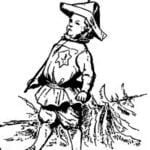
“Now life is beginning again,” said the tree, rejoicing in the sunshine and fresh air. Then it was carried down stairs and taken into the courtyard so quickly, that it forgot to think of itself, and could only look about, there was so much to be seen.
The court was close to a garden, where everything looked blooming. Fresh and fragrant roses hung over the little palings. The linden-trees were in blossom; while the swallows flew here and there, crying, “Twit, twit, twit, my mate is coming,”— but it was not the fir-tree they meant. “Now I shall live,” cried the tree, joyfully spreading out its branches; but alas! they were all withered and yellow, and it lay in a corner amongst weeds and nettles.
The star of gold paper still stuck in the top of the tree and glittered in the sunshine. In the same courtyard two of the merry children were playing who had danced round the tree at Christmas, and had been so happy. The youngest saw the gilded star, and ran and pulled it off the tree.
“Look what is sticking to the ugly old fir-tree,” said the child, treading on the branches till they crackled under his boots. And the tree saw all the fresh bright flowers in the garden, and then looked at itself, and wished it had remained in the dark corner of the garret.
It thought of its fresh youth in the forest, of the merry Christmas evening, and of the little mice who had listened to the story of “Humpty Dumpty.” “Past! past!” said the old tree; “Oh, had I but enjoyed myself while I could have done so! but now it is too late.”
Then a lad came and chopped the tree into small pieces, till a large bundle lay in a heap on the ground. The pieces were placed in a fire under the copper, and they quickly blazed up brightly, while the tree sighed so deeply that each sigh was like a pistol-shot.
Then the children, who were at play, came and seated themselves in front of the fire, and looked at it and cried, “Pop, pop.” But at each “pop,” which was a deep sigh, the tree was thinking of a summer day in the forest; and of Christmas evening, and of “Humpty Dumpty,” the only story it had ever heard or knew how to relate, till at last it was consumed.
The boys still played in the garden, and the youngest wore the golden star on his breast, with which the tree had been adorned during the happiest evening of its existence.
Now all was past; the tree’s life was past, and the story also, — for all stories must come to an end at last.
~ ○ ~
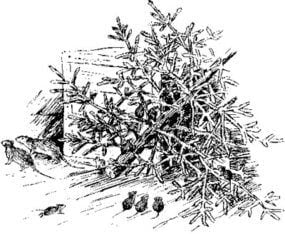
Do not let your Christmas tree go to waste, use it.
Ethnobotany: Use of the fir tree
Common names:
- Balsam Fir
- Canada Balsam
- Christmas Tree
- Fir
- Fir Balsam
- Fir Pine
- Sapin
- Silver Fir
- Silver Pine
The use of the fir tree in history, heritage and daily life
Herbal medications made from the tree have been traditionally in use in Asia, America as well as Europe. The fir has been known to benefit the human body by:
- its ability to soothe over-worked muscles, tendons, ligaments, and joints
- reducing cortisol levels — thereby reducing stress, anxiety, tension, and depression
- healing respiratory conditions — as asthma, bronchitis, and coughs
treating colds, flu, sore throat, and fever - significantly reducing pain for those who suffer from fibromyalgia, back pain, rheumatic pain, and a multitude of inflammatory conditions
- preventing infection of cuts & wounds
- grounding & balancing the mind
The Buds
Fir buds are tender and high in vitamin C, potassium, and magnesium. They can be eaten right off the tree in spring. The young spring buds are florescent and lime against the backdrop of the dark needles. At this young stage the needles are tender and citrus-y, with a slight sour note nodding to it’s outstanding antioxidant properties. In the fall, when the needles are seasoned, they take on a deeper, more balsamic note.
The Needles
The needles contain a wide variety of monoterpenes such as α-pinene, β-pinene, limonene, myrcene, camphene, Δ3-carene, and terpinolene, as well as monoterpene alcohols such as α-terpineol, terpinen-4-ol, linalool, citronellol, and fenchyl alcohol.
Other fir constituents include esters and aldehydes. With these functional constituent groups in mind, the fir offers anti-inflammatory, antiseptic, antimicrobial (bacterial, viral and fungal), expectorant, and sedative properties.
Traditional uses of fir needles include for the common cold and chest complaints, asthma, headache, liver stagnancy, and inflammatory conditions such as rheumatism and arthritis. You can also use spruce needles to make tea.
According to Anderman, spruce needle tea could have beneficial anti-cold and flu properties. Needles can also be put into honey and taken during winter times as a cold remedy. The aromatic needles are used as a moth repellent. A powder made from the dried and crushed needles was used as a baby powder by the North American first peoples.
The Bark
The cambium (the soft inner bark) can be dried and ground into a flour. It is high in vitamin C. A pink dye can be obtained from the bark. Native Americans would smoke the root or bark and inhale the fumes and use the bark as a waterproof covering material for buildings and canoes.
The Resin
When wounded, firs exudes resin which helps seal wounds and prevent insects, fungi, and bacteria from further harming the tree. The resin has antiseptic and pain relieving properties.
Traditionally, it was applied to wounds to help seal them and discourage infection. The dried and hardened pitch can be chewed as a tooth cleanser. Some people make topical salves from fir resin. That said, resin causes dermatitis in some and may irritate mucous membranes.
Fir essential oil
The topical uses of fir essential oil include antiseptic uses, pain relief for aching muscles and stimulation of the circulation and detoxification of the body via the skin.
One of the most well-known uses is in the improvement of respiratory function by supporting the loosening of bronchial mucous as well as anti-inflammatory effect on the throat and bronchi.
Another less well known effect is that of stimulating the metabolism and stimulating digestive function and heart rate. Last but not least, the pleasant smell of fir needle essential oil can be wonderful for people who suffer from body odor, leaving us smelling fresh as a forest!
Note: This article does not contain medical advice. Please ask a health practitioner before trying therapeutic products new to you.
If you do wish to experiment, we suggest doing further research.
Economic Uses Of Fir trees:
Firs are highly desirable for use as Christmas trees, and in some areas they are grown on plantations established for this purpose. They can be pruned to develop a thick canopy with a pleasing shape, and firs retain their foliage for a rather long time, even inside dry homes during the winter.
True firs are used to manufacture a rough lumber, suitable for framing buildings, making crates, manufacturing plywood, and other purposes that do not require a fine finish. The Douglas fir is an important species for the manufacturing of a higher-grade lumber.
The viscid, yellowish turpentine that is secreted by balsam fir, and can be collected from the resinous blisters on the stems of these trees.
Turpentine is now a minor economic product, but it used to be important as a clear-drying, mounting fixative for microscope slides, and as a cement for optical lenses – it has a high refractive index resembling that of glass. It is used medicinally and in dentistry, also in the manufacture of glues, dry cleaning, insecticides, candles and as a fixative in soaps and perfumery.
It is also used in artificial flavors such as lemon, peppermint, and nutmeg, as well as cosmetics.
Varnish is made of fir resin combined with a solvent and drying oil (also derived from plants) to make it easier to apply to surfaces. It is commonly used for wood finishing and other crafts to provide protection and a glossy finish. Natural lacquer is simply liquid resin. It is not mixed with any other solvents.

~ ○ ~
Keep exploring:
Works Cited & Multimedia Sources
- Märchen von Hans Christian Andersen. Berlin 1910.
- Andersen Hans Christian. Fairy Tales and Stories. Original Illustrations by Vilhelm Pedersen and Lorenz Frölich. English: Paull H. P. 1872.
- Illustrations by ©Annuka Sanna, ©Caterina Malisano and Vilhelm Pedersen and Lorenz Frölich.
- The H.C. Anderson Centret.
- Discover more Hans Christian Anderson on earthstoriez
